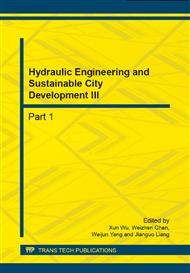p.127
p.132
p.137
p.141
p.145
p.149
p.156
p.162
p.167
Deposition Morphology of Tributary Zhenshui in Xiaolangdi Reservoir
Abstract:
Zhenshui is the biggest tributary of Xiaolangdi Reservoir, and its original storage capacity is 1.767 billion m3 and accounts for 33.5% of the tributary. By October 2013, the amount of sediment in Zhenshui reached 0.2365 billion m3, and the sand bar was 5.78m in height. Influenced by operational mode of reservoir and terrain, the formation of sand bar at Zhenshui estuary has certain inevitabilities. The sand bar can prevent water and sediment exchange between mainstream and tributary, and the internal storage capacity of tributary is not effectively used. Analyzing sand bar and its cause can supply some technical supports for prevention.
Info:
Periodical:
Pages:
145-148
Citation:
Online since:
September 2014
Authors:
Price:
Сopyright:
© 2014 Trans Tech Publications Ltd. All Rights Reserved
Share:
Citation:


